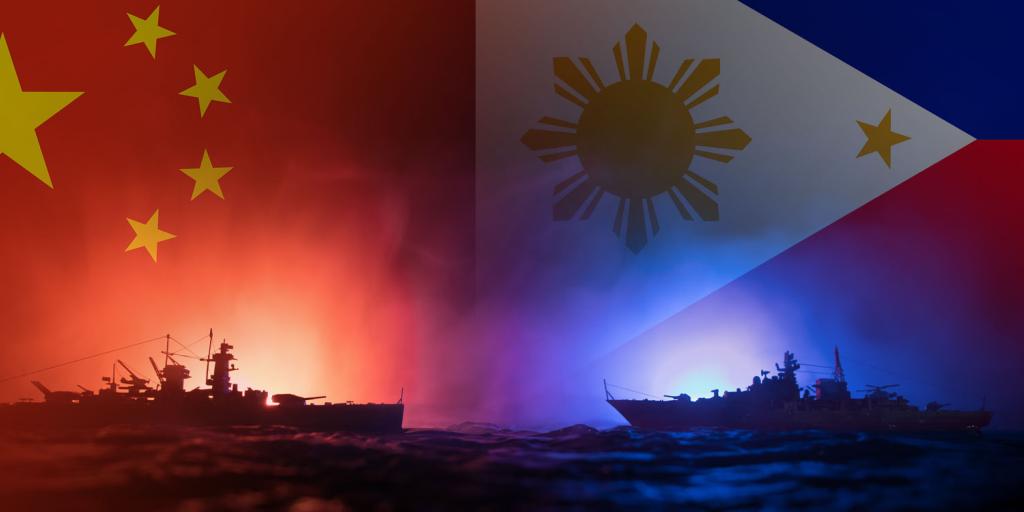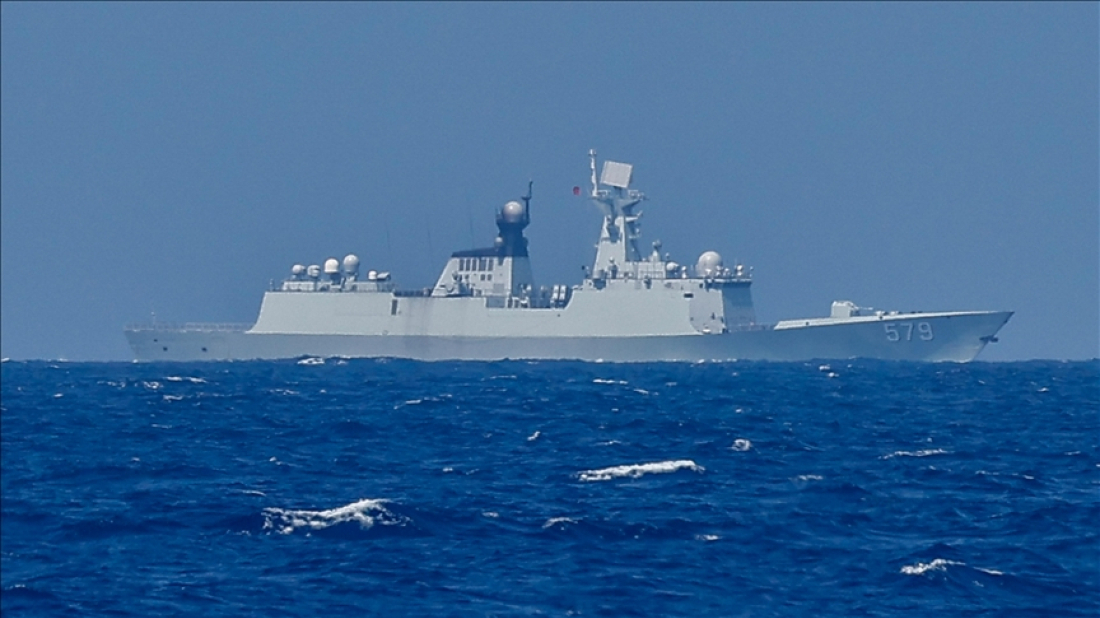China and the Philippines have each raised their national flags on tiny sandbars in the South China Sea, staking competing sovereignty claims in waters that have become a potential flashpoint for global conflict.
The rival flag-raising occurred on Sandy Cay, a cluster of three uninhabited sandbars near a Philippine military outpost in the disputed Spratly Islands.
The release of these images comes as US and Philippine forces conduct their largest-ever joint military drills in nearby waters – just weeks after US Defense Secretary Pete Hegseth pledged to strengthen the US-Philippines military alliance to counter China’s regional aggression during his first Asia trip.
Parts of the South China Sea, vital to global trade, are claimed by multiple nations. However, China asserts near-total control, defying an international court ruling. Over the past two decades, China has built military installations on reefs and atolls far from its coastline.
The public relations battle over Sandy Cay risks intensifying tensions between the Philippines and China and presents a key test for US policymakers, especially with Trump administration officials stressing the need to counter China’s growing influence in the Indo-Pacific.
Competing Claims
The latest dispute surfaced when China’s state-controlled media claimed that its Coast Guard had asserted maritime control over Tiexian Reef (Sandy Cay) in mid-April. Photos aired by Chinese state broadcaster CCTV showed Chinese officers on the sandbar, raising a flag as part of a demonstration of sovereignty.
CCTV reported that China’s Coast Guard officers had “patrolled” the reef and collected evidence of alleged illegal activities by the Philippine side, also cleaning up debris.
In response, the Philippines quickly organized a publicity effort, sending naval and coast guard teams to various sandbars, including Pag-asa Cay (Sandy Cay), where they observed the presence of Chinese vessels.
A photo posted by a Philippines Coast Guard spokesperson showed officers raising the Philippine flag on the sandbar. Philippine officials claimed that China had falsely reported its control over the area, releasing photos and videos to debunk the disinformation.

Military Alliances and Escalating Tensions
Sandy Cay lies near Thitu Island, also known as Pag-asa Island, which houses a Philippine military facility. In 2023, Manila opened a coast guard base there in response to Chinese aggression. Under the Biden administration, US officials have assured the Philippines of defense support in case of an attack in the South China Sea.
As the US and Philippine military drills kicked off in April, the US deployed an anti-ship missile launcher for the first time in northern Philippines, near Taiwan, further straining relations with Beijing. This year’s Balikatan exercises, also featuring Japan’s participation, are a sign of expanding security cooperation in the region.
Denying Chinese Claims
The Philippines has rejected China’s assertion that it had “dealt with” a mission involving Filipino personnel who allegedly landed on the disputed reef. Chinese authorities claimed that they had “investigated” the situation and urged the Philippines to stop its alleged infringement.
Manila officials denied that China had seized Sandy Cay or interfered with the Philippine mission, labeling China’s statements as part of disinformation tactics. They pointed to photos showing the Philippine flag raised on the sandbars, disputing China’s claims of territorial sovereignty.
In response to the military exercises and escalating tensions, Chinese media noted that Beijing’s flag-raising on Sandy Cay was a significant move to assert its claim, especially ahead of US-Philippine military drills, sending a message to both Manila and Washington.

What’s Behind Escalating China-Philippines Tensions in the South China Sea?
The territorial dispute between China and the Philippines in the South China Sea has intensified, with violent confrontations becoming increasingly frequent. Allegations of intentional boat rammings, the use of water cannons, and physical altercations involving spears and knives between the two nations’ forces have escalated tensions. In August 2024 alone, the two countries reported six confrontations, five of which occurred near Scarborough Shoal and the Sabina Shoal, located within the Philippines’ 200-nautical-mile Exclusive Economic Zone (EEZ) but claimed by China.
Despite efforts from both sides to manage their maritime dispute, the situation remains volatile. The confrontations follow a violent clash in June, where a Filipino sailor lost a finger. China has accused the Philippines of intruding into its territory, while Manila insists that Beijing’s actions are unlawful. In September, Beijing warned that its relationship with the Philippines stood at a “crossroads,” urging Manila to reconsider its stance.
The growing tensions have prompted concerns from the United States, a long-time ally of the Philippines. Under their mutual defense treaty, the U.S. has pledged to defend Philippine troops from any armed attacks, including those targeting coastguard personnel, aircraft, or vessels in the South China Sea.
Who Claims What?
The South China Sea is a vital and contested waterway, with China claiming nearly all of it via a vague, U-shaped “nine-dash-line” that overlaps with the EEZs of several nations, including the Philippines. This massive claim extends over important areas such as the Paracel and Spratly Islands. The Philippines, along with Brunei, Malaysia, and Vietnam, also claims parts of the Spratlys, while China maintains dominance over many of these islands, particularly since 1974.
In 2016, a United Nations tribunal ruled that China’s claims based on the nine-dash-line lacked legal grounding, but Beijing has ignored the verdict, continuing to militarize reefs and submerged shoals in the region.
China’s Military Build-up in the South China Sea
Since 2013, China has undertaken extensive land reclamation efforts in the Spratlys, adding 3,200 acres of new land. These artificial islands now feature military outposts, including large runways and ports capable of hosting military aircraft and assets. China’s military presence includes anti-ship and anti-aircraft missiles, strengthening its strategic foothold in the region.
The Philippines and Vietnam have also established their own outposts in the South China Sea, but none match China’s scale or military infrastructure.
Why is the South China Sea So Important?
The South China Sea is a critical trade route, with cargo worth $3.4 trillion passing through it annually. It also harbors rich fishing grounds, essential for the livelihoods of millions of people. The waters are believed to contain significant oil and gas reserves, with potential reserves worth over $2.5 trillion. Control of these resources is key to energy security for the region’s nations.
China’s military presence serves not only to exert control over vital resources but also to deny foreign military access, particularly from the United States. This has led to direct confrontations with vessels from other claimant nations such as Vietnam, Malaysia, and the Philippines, which have sought to explore and exploit these resources.
Increasing Clashes
The dispute is not new. Over the decades, China has clashed with both Vietnam and the Philippines over sovereignty claims. In 1974, China seized the Paracels from Vietnam, resulting in the deaths of more than 70 Vietnamese troops. The Philippines has faced its most significant challenges over Scarborough Shoal and Second Thomas Shoal. In 2012, China seized Scarborough Shoal after a tense standoff, and more recently, Chinese forces have attempted to block Filipino ships delivering supplies to troops stationed on Second Thomas Shoal.
The use of military-grade lasers, boat rammings, and water cannons has become a tactic of choice for China in asserting its dominance. These confrontations highlight the ongoing volatility in one of the world’s most strategically important maritime regions.


